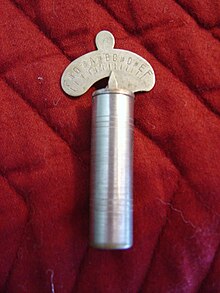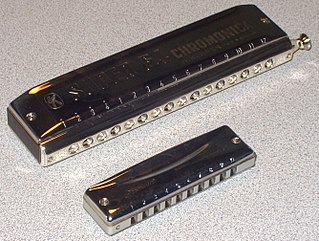
The harmonica, also known as a French harp or mouth organ, is a free reed wind instrument used worldwide in many musical genres, notably in blues, American folk music, classical music, jazz, country, and rock. The many types of harmonica include diatonic, chromatic, tremolo, octave, orchestral, and bass versions. A harmonica is played by using the mouth to direct air into or out of one holes along a mouthpiece. Behind each hole is a chamber containing at least one reed. The most common is the diatonic Richter-tuned with ten air passages and twenty reeds, often called the blues harp. A harmonica reed is a flat, elongated spring typically made of brass, stainless steel, or bronze, which is secured at one end over a slot that serves as an airway. When the free end is made to vibrate by the player's air, it alternately blocks and unblocks the airway to produce sound.
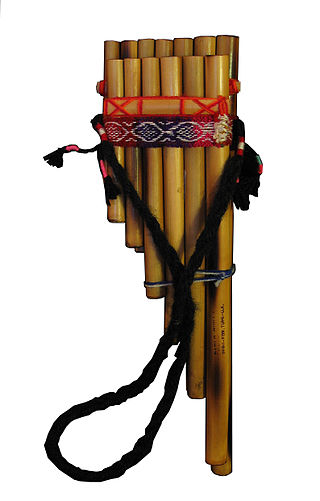
A pan flute is a musical instrument based on the principle of the closed tube, consisting of multiple pipes of gradually increasing length. Multiple varieties of pan flutes have been popular as folk instruments. The pipes are typically made from bamboo, giant cane, or local reeds. Other materials include wood, plastic, metal and ivory.

The tin whistle, also called the penny whistle, is a simple six-holed woodwind instrument. It is a type of fipple flute, putting it in the same class as the recorder, Native American flute, and other woodwind instruments that meet such criteria. A tin whistle player is called a whistler. The tin whistle is closely associated with Irish traditional music and Celtic music. Other names for the instrument are the flageolet, English flageolet, Scottish penny whistle, tin flageolet, or Irish whistle.
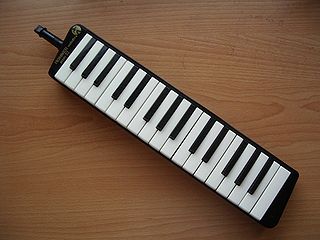
The melodica is a handheld free-reed instrument similar to a pump organ or harmonica. It features a musical keyboard on top, and is played by blowing air through a mouthpiece that fits into a hole in the side of the instrument. The keyboard usually covers two or three octaves. Melodicas are small, lightweight, and portable, and many are designed for children to play. They are popular in music education programs, especially in Asia. The modern form of the instrument was invented by Hohner in the late 1950s, though similar instruments have been known in Italy since the 19th century.

The uilleann pipes are the characteristic national bagpipe of Ireland. Earlier known in English as "union pipes", their current name is a partial translation of the Irish language terms píobaí uilleann, from their method of inflation. There is no historical record of the name or use of the term uilleann pipes before the 20th century. It was an invention of Grattan Flood and the name stuck. People mistook the term 'union' to refer to the 1800 Act of Union; this is incorrect as Breandán Breathnach points out that a poem published in 1796 uses the term 'union'.

The sheng is a Chinese mouth-blown polyphonic free reed instrument consisting of vertical pipes.

A free reed aerophone is a musical instrument that produces sound as air flows past a vibrating reed in a frame. Air pressure is typically generated by breath or with a bellows. In the Hornbostel–Sachs system, it is number: 412.13. Free reed instruments are contrasted with non-free or enclosed reed instruments, where the timbre is fully or partially dependent on the shape of the instrument body, Hornbostel–Sachs number: 42.

The great Highland bagpipe is a type of bagpipe native to Scotland, and the Scottish analogue to the great Irish warpipes. It has acquired widespread recognition through its usage in the British military and in pipe bands throughout the world.
Overblowing is the manipulation of supplied air through a wind instrument that causes the sounded pitch to jump to a higher one without a fingering change or the operation of a slide. Overblowing may involve a change in the air pressure, in the point at which the air is directed, or in the resonance characteristics of the chamber formed by the mouth and throat of the player.

The zhaleika, also known as bryolka (брёлка), is a Slavic wind instrument, most used in Belarusian, Russian and sometimes Ukrainian ethnic music. Also known as a "folk clarinet" or hornpipe. The zhaleika was eventually incorporated into the balalaika band, the Hungarian tarogato, and may have contributed to the development of the chalumeau, a predecessor of the clarinet.

Hohner Musikinstrumente GmbH & Co. KG is a German manufacturer of musical instruments, founded in 1857 by Matthias Hohner (1833–1902). The roots of the Hohner firm are in Trossingen, Baden-Württemberg. Since its foundation, and though known for its harmonicas, Hohner has manufactured a wide range of instruments, such as kazoos, accordions, recorder flutes, melodicas, banjos, electric, acoustic, resonator and classical guitars, basses, mandolins and ukuleles.

The Richter-tuned harmonica, or 10-hole harmonica or blues harp, is the most widely known type of harmonica. It is a variety of diatonic harmonica, with ten holes which offer the player 19 notes in a three-octave range.
There are numerous techniques available for playing the harmonica, including bending, overbending, and tongue blocking.

An organ pipe is a sound-producing element of the pipe organ that resonates at a specific pitch when pressurized air is driven through it. Each pipe is tuned to a note of the musical scale. A set of organ pipes of similar timbre comprising the complete scale is known as a rank; one or more ranks constitutes a stop.
The chromatic harmonica is a type of harmonica that uses a button-activated sliding bar to redirect air from the hole in the mouthpiece to the selected reed-plate desired. When the button is not pressed, an altered diatonic major scale of the key of the harmonica is available, while depressing the button accesses the same scale a semitone higher in each hole. Thus, the instrument is capable of playing the 12 notes of the Western chromatic scale. The chromatic harmonica can thus be contrasted with a standard harmonica, which can play only the notes in a given musical key.
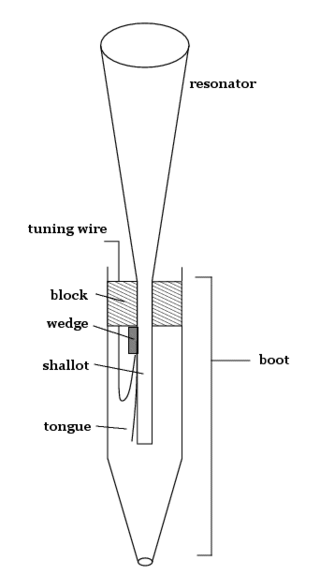
A reed pipe is an organ pipe that is sounded by a vibrating brass strip known as a reed. Air under pressure is directed towards the reed, which vibrates at a specific pitch. This is in contrast to flue pipes, which contain no moving parts and produce sound solely through the vibration of air molecules. Reed pipes are common components of pipe organs.
This article defines a number of terms that are exclusive, or whose meaning is exclusive, to piping and pipers.

A tremolo harmonica is a type of diatonic harmonica, distinct by having two reeds per note. In a tremolo harmonica, the two reeds are tuned slightly off a reference pitch, one slightly sharp and the other slightly flat. This gives a unique wavering or warbling sound created by the two reeds being not exactly in tune with each other and difference in their subsequent waveforms acting against one another. The degree of beating can be varied depending on the desired effect. Instruments where the beating is faster due to the reeds being farther apart from the reference pitch are called "wet", whereas those where the beating is slower and less noticeable due to the reeds being more closely in tune are called "dry".
Svirel is a Slavic wind instrument of the end-blown flute type used in Russia, Belarus, and Ukraine. It is a parallel-bore flute. Six-hole versions are similar to the tin whistle; ten-holes are fully chromatic.

